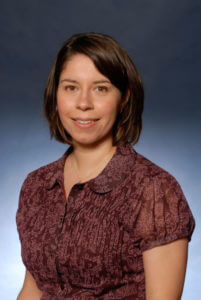August 27, 2018
NIH grant to provide new research opportunities for science students

Veronica Contreras-Shannon, Ph.D.
The National Institutes of Health have awarded St. Mary’s University a research grant of $405,000 to study the cells that can exacerbate atherosclerosis, commonly known as hardening of the arteries.
Sponsored by the National Institute of General Medical Sciences, the grant will provide $135,000 annually for three years and will fund a project led by principal investigator Verónica Contreras-Shannon, Ph.D., Associate Professor of Biological Sciences. It will also allow her to offer more research opportunities to students, dedicate a significant amount of her time to the project, and work with a team of mentors in different disciplines.
“Cardiovascular disease risk disproportionately affects Hispanics, impacting the families and communities to which our students belong, both here at St. Mary’s and at home,” Contreras-Shannon said.
“This grant will provide research opportunities that will improve and inform students’ understanding of science and cardiovascular disease, as well as better prepare our students for the biomedical workforce,” Contreras-Shannon said.
The grant stems from the Support of Competitive Research (SCORE) Program which seeks to build research capacity at universities that have not traditionally received research funding, Contreras-Shannon said. According to the SCORE website, the program funnels resources to universities — like St. Mary’s with its legacy as a Hispanic-Serving Institution with many first-generation students — that have historically “focused on training and graduating students from groups nationally underrepresented in biomedical research.”
“This award recognizes the work being done by an outstanding faculty member,” said Winston Erevelles, Ph.D., Dean of the School of Science, Engineering and Technology (SET). “The project is consistent with our mission as a Catholic and Marianist University, and advances the SET vision of developing ethical and service-minded leaders in STEM through experiential learning in a very meaningful way.”
St. Mary’s undergraduate students who participate in research have significantly higher graduation rates and average GPAs at graduation, according to data collected by the School of Science, Engineering and Technology.
“This grant is a huge advancement toward our overall departmental plans for increasing opportunities for our students to engage in meaningful research activities on our campus,” said Timothy Raabe, Ph.D., Associate Dean, and Chair and Professor of Biological Sciences. “This has a direct impact on student performance.”
More about the atherosclerosis research project
Contreras-Shannon will study the cells that form part of the plaques that cause narrowing of the arteries and the progression of atherosclerosis. Experts believe that atherosclerosis and plaque development occur when arteries become damaged and an inflammatory response ensues.
An inflammatory response occurs when cells get injured and damaged cells signal for help from white blood cells. The white blood cells travel to the damaged tissue to minimize infection, clean up the damage and aid the healing process. In the case of atherosclerosis, the cells lining a person’s arteries may be injured by smoking, high blood pressure or high cholesterol.
However, when the white blood cells arrive on the scene in response to the damage, they consume cholesterol droplets and turn into foam cells. These enlarged cells, containing bubbles of fat, promote more inflammation and create products that can further damage other cells in the blood vessel. This initiates a vicious, inflammation-causing cycle that exacerbates the disease. Current treatments for atherosclerosis focus on prevention or vessel repair with very few targeting the cellular events leading to the progression of atherosclerosis, Contreras-Shannon said.
Contreras-Shannon will investigate whether specific proteins are involved in the formation and function of foam cells, which may provide a target for drugs to prevent the development of foam cells and atherosclerosis.
